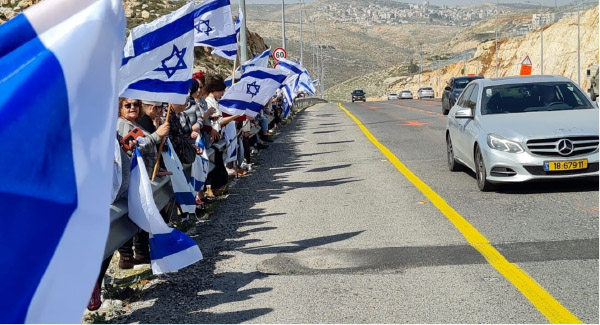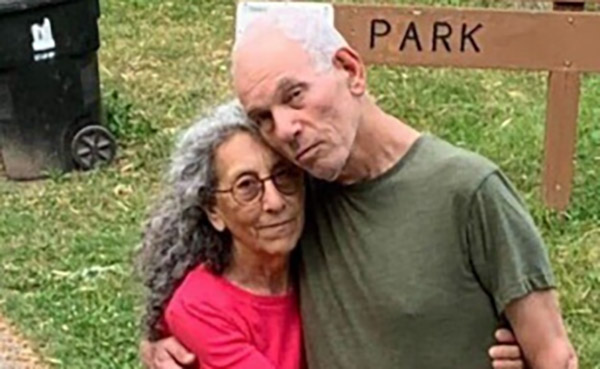By Leah Garber
Pride, honor, and symbols “A flag, what is it? A picket and a cloth? No, sir! A flag is above that. With a flag, people are led wherever they want, and even to the land of destiny. They live and die for a flag, it is the only thing for which they are willing to die en masse, if they are educated for it.” —Theodor Herzl The blue and white Israeli flag, decided upon as the Jewish state’s flag in 1897 at the First Zionist Congress, has reclaimed its glory this past year, fulfilling Herzl’s notion. Not that what the flag stands for has ever faded, but last year’s mass protests against the judiciary reform were mostly identified by the thousands of Israeli flags carried at every protest. Inspired by the democratic values of Israel, flags were carried with great pride, representing the two basic principles the state was founded on: To be a Jewish and democratic homeland for the Jewish people. During this time of protest, every Shabbat evening, Israel’s night skies were colored blue and white, with hundreds of thousands of flags flown with pride, declaring a solid commitment to what the flag represents. The October 7 massacre single-handedly removed the judiciary reform from the government’s agenda and, with it, the protests. This moment draws more than ever on the power of the Israeli flag and other national symbols in the minds of the Israeli public, reminding us of the tremendous pride we all have in our country and the values that iconography represents. The long journey made by the Jewish people through May 14, 1948, when Israel’s first Prime Minister, David Ben-Gurion, announced the “Establishment of a Jewish State in Eretz-Israel, to be known as the State of Israel.” The symbols of the state signify the journeys of the past, the longing for a sovereign Jewish state, and the willingness of her people to sacrifice for the sake of preserving our home, this one home we share. Those who were massacred, murdered, and killed on October 7, and the IDF soldiers who were killed in the battles that followed, pass on their last journey towards their eternal rest through endless convoys of Israelis waving the Israeli flag as if clinging to our unifying strength and motivation, to what represents us, and to the values for which we live, and unfortunately die upholding.

The war is brutal, cruel, and exacts painful sacrifices. The human cost has not spared any sector. The people of Israel pay it as one: Jews and Arabs, religious and secular, the people of the city alongside the people of the settlements, right and left alike. The pain, the loss, and the never-ending grief embrace us all. And just like our determined soldiers on the front fighting shoulder to shoulder, so are we in the rear, strengthened by each other, leaving behind past sentiments and conflicts. The flag, the Star of David, and the national anthem belong to all of us, and we all wrap ourselves in these symbols, seeking their comfort. More and more people are wearing jewelry with the Star of David, highlighting their belonging to the Jewish people, seeking to carry the national identity proudly. The flag is waved from every house, and our streets are decorated with huge flags next to the inscription “Together We Will Win,” and every solidarity rally with the families of the hostages ends with the singing of the national anthem. Hatikvah—our hope. In Israel, the color yellow is synonymous with the struggle to free the hostages, with the color yellow marking our daily lives. It reminds us of the bright sunlight the hostages have not seen in 74 days. Along with the iconic blue and white, these colors mark the way and outline the path to our destination. We were attacked, slaughtered, killed, and kidnapped because we are Israelis, and we are willingly fighting for our only home with pride. 70-year-old Judy Weinstein, originally from the United States, is the oldest abducted woman held captive by Hamas. Judy was kidnapped from her home in Kibbutz Nir Oz when she went for a morning walk. Her husband, Gadi, was shot and murdered on the spot, and his body was taken to Gaza. Judy was injured in this murderous attack and was dragged to Gaza while bleeding from the gunshots. Israel has no information about the condition of Judy, who may not even know she is now a widow, a 70-year-old woman who is held for 74 days in the jaws of the monster.

Kfir Bibas is the youngest person who was kidnapped when, together with his brother Ariel and their mother Shiri, they were taken to Gaza. Their father was kidnapped separately, and while wounded, he was kept apart from his family. We marked Kafir’s 10-month birthday, and we are marking his 11-month birthday this week, will baby Kafir celebrate his one-year birthday in captivity? Is he taking his first steps, or does the tunnel’s darkness and terror prevent him from moving? Perhaps he does not have the strength, the will, or the desire to try to take his first baby steps in the world that failed in its promise to see him run freely in the green of the kibbutz’s fields. Hamas murderers announced that Shiri and her two sons are not alive, but there is no proof of this, and therefore, as far as their family is concerned, and with them, the entire nation, they are alive and must be returned home immediately. These two red-haired brothers became the icons of all hostages, symbolizing Israeli beauty, childhood, freedom, and life. But their image as hostages also symbolizes the evil and cruelty of their captors.

We long for the Bibas family to smile together once again and for the moment when we will welcome home all 129 hostages who are still in captivity. We will carry Israeli flags with pride, We long for the Bibas family to smile together once again and for the moment when we will welcome home all 129 hostages who are still in captivity. We will carry Israeli flags with pride, remove the yellow bracelets that will no longer be needed, and, with hearts full of gratitude, sing our national anthem, allowing ourselves one joyous moment in this long battle over our home and for the sake of our future.
Together, united, we will overcome.
Leah Garber is a senior vice president of JCC Association of North America and director of its Center for Israel Engagement in Jerusalem.
Reader Interactions